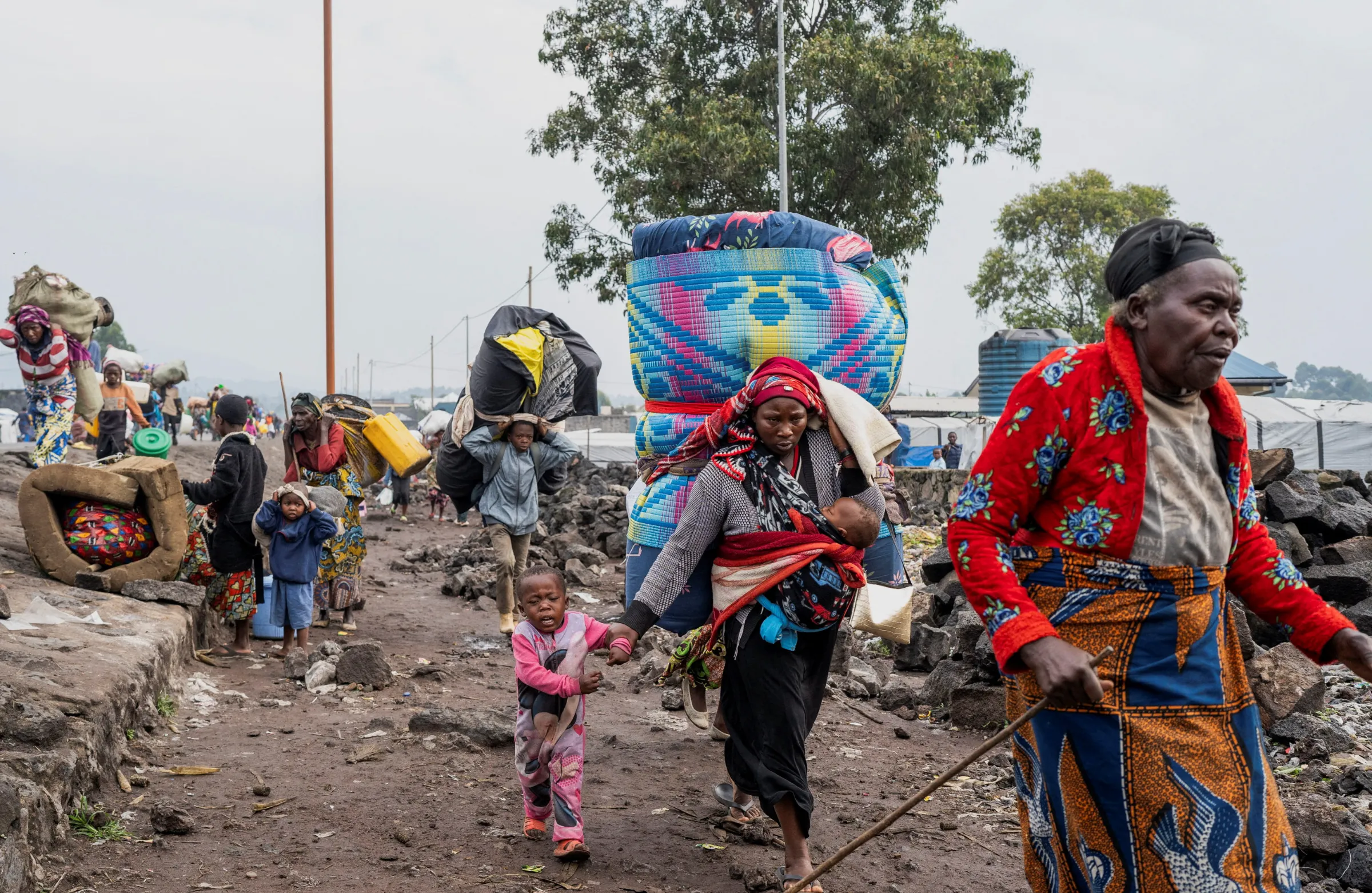What is driving the war in Congo and what is the human cost?

Internally displaced civilians carry their belongings as they flee following the fight between M23 rebels and the Armed Forces of the Democratic Republic of the Congo (FARDC), in Goma, eastern Democratic Republic of Congo, January 26, 2025. REUTERS/Aubin Mukoni
What’s the context?
The mineral-rich east of Congo is again in turmoil as M23 rebels advance; how have decades of conflict affected the people?
After years of conflict fuelled by the plundering of mineral resources, and with the global aid system in turmoil, fighting in the eastern Democratic Republic of Congo has exposed millions to what U.N. experts have called "unimaginable hardship".
Eastern provinces have been wracked by some three decades of violence by state and non-state actors fighting to control gold mines and rich reserves of tin ore, coltan and tungsten ore, exacerbating one of the world's worst humanitarian crises.
The capture of Goma, a key trade and transport hub, on Jan. 27 by Rwandan-backed M23 rebels after weeks of fighting with Congolese military forces marks the biggest escalation since 2012 of a conflict that also has roots in the Rwanda genocide.
The U.N. Office for the Coordination of Humanitarian Affairs has estimated at least 2,800 people died in Goma, with a spokesperson describing the human toll as "staggering".
The battle for Goma displaced hundreds of thousands of people and has fanned fears of a wider regional war.
M23 rebels announced a ceasefire on Feb. 3, but just days later, they captured the mining town of Nyabibwe on Lake Kivu in an apparent violation of their unilateral ceasefire.
This is what you need to know about the conflict and its human cost.
Decades of conflict
The M23 group, formed in 2012, is the most powerful of a succession of ethnic Tutsi-led, Rwandan-backed insurgents in the eastern DRC since the genocide in Rwanda in 1994.
Rwanda denies backing the M23, but has come under increasing international pressure since the M23 captured Goma with foreign powers, including the United States and European Union, condemning its involvement. U.N. reports say Rwanda has deployed thousands of its own troops in support of the M23.
The U.N. and global powers fear this new conflict could spiral into a wider regional war, akin to those of 1996-1997 and 1998-2003 that killed millions, mostly from hunger and disease.
Today, more than 100 armed groups are operating in eastern DRC, according to rights group Amnesty International, which has accused both the Congo's army and militia groups of carrying out several attacks that "likely constitute war crimes."
Congo has called on the international community to impose sanctions on Rwanda and keep the peace in the wider region.
There are around 11,000 U.N peacekeepers in DRC, mostly in the east.
Humanitarian cost of conflict
The latest bout of fighting has forced around 700,000 people to flee their homes, the United Nations said in early February.
Camps sheltering displaced people have been bombed and fighters have also occupied schools and hospitals.
"There are severe shortages of food and shelter. There is no electricity or drinking water, heightening the risk of infectious outbreaks in a region prone to epidemics," a team of U.N. experts said in a statement on Feb. 6.
"Medical facilities are overwhelmed, and cannot adequately care for the injured, dispose of the dead, and treat survivors of sexual and gender-based violence. The situation is compounded by widespread looting of humanitarian facilities and denials of humanitarian access," the statement said.
The World Food Programme said that even before the capture of Goma, nearly a quarter of DRC's people were already in crisis and emergency levels of food security.
It said that over the next five months, 4.5 million children aged under 5, and 3.7 million pregnant and breastfeeding women are expected to face acute malnutrition.
U.N. human rights chief Volker Turk said last week the worst could be yet to come, adding he was horrified by emerging, multiple reports of rape, gang rape and sexual slavery.
The World Health Organization (WHO) has also warned of potential disease outbreaks as bodies continue to be recovered.
Massive aid needs
Aid agencies say they need $2.5 billion for humanitarian assistance for DRC in 2025, with at least $50 million needed immediately to address displacement and care for victims, the U.N. said.
President Donald Trump's decision to halt USAID funding for some humanitarian programmes is also expected to hamper relief efforts, according to the U.N.
It also said there were reports the M23 rebels had instructed NGOs to stop operations in areas under their control.
Resource-rich, but poor
Congo has most of the world's cobalt reserves, critical to the energy industry. It also has oil, copper, diamonds, gold, and other rare metals, most of which are located in the east. Its mineral wealth is estimated at $24 trillion.
M23 fighters have seized control of several lucrative mines, including one in Rubaya, which has one of the world's largest coltan deposits, used to power laptops and smartphones.
But Congo is still one of the poorest countries in the world, and development experts say the exploitation of resources by both internal and external actors is a key factor.
More than 70% of DRC's 100 million people were living in extreme poverty in 2024, according to the World Data lab.
(Reporting by Bukola Adebayo; Editing by Jon Hemming.)
Context is powered by the Thomson Reuters Foundation Newsroom.
Our Standards: Thomson Reuters Trust Principles
Tags
- Government aid
- War and conflict
- Poverty
- Migration

















